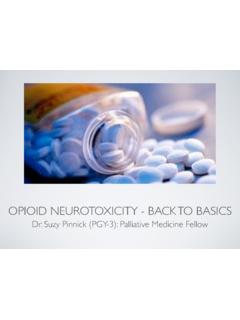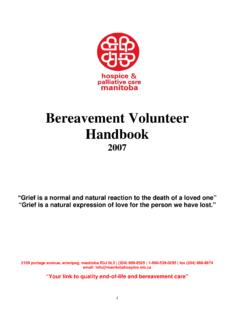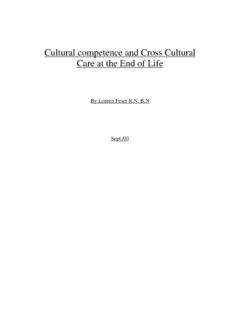Transcription of Kennedy Terminal Ulcers - Canadian Virtual Hospice
1 Are All Pressure Ulcers Preventable? Kennedy Terminal Ulcers (KTUs) versus Pressure Ulcers Sarah Brown BSc,RN,MN & Alex Beel RN,MN,CHPC (C) Clinical Nurse Specialists WRHA Palliative Care Program Presentation Overview What is the Kennedy Terminal ulcer ? Review of the Literature What are the 5 characteristics of a KTU? How do I know the difference between KTU and PU? Review Goals of Care for KTU Review of case studies What are we talking about? Kennedy Terminal Ulcers (KTU) Unavoidable skin breakdown or skin failure that occurs as part of the dying process (Schrank, 2009).
2 History: First noted by Karen Lou Kennedy in 1983. Started a Skin Care Team and noticed some people got pressure sores that had a similar look and two weeks later they had died. 1989 First described at the National Pressure ulcer Advisory Panel (NPUAP). Skin Failure: An event in which the skin and underlying tissue die due to hypoperfusion that occurs concurrent with severe dysfunction of other organ systems (Langemo & Brown, 2006) Skin integrity is dependent on the function of all other organ systems for nutrition, circulation and immune function.
3 For example, although our skin is approximately 10-15% of total body weight, it requires approximately 25 33% of cardiac output. Unlike other failing organs, skin changes are visible Etiology: Further research is needed; Very little evidenced based research; use expert consensus. Occurrence of KTU is hypothesized to be shunting blood away from the skin to the other organs during the process of dying. Why should I be concerned? Pressure ulcer Facts: In general, are more common in cancer patients Up to 24% prevalence in PCH residents Among those developing a PU in hospital, more than half will die in the next 12 months Recent discussions: As all Stage III PU are considered preventable, should they be reported as a critical incident?
4 Pressure ulcer care and documentation seem to be subject to increasing regulatory scrutiny. Literature on Pressure Ulcers : Kennedy (1989) 5 year retrospective study: Approx. N = 500 found of persons with PU in long-term care facility died within 6 weeks of onset Hason et al (1991): of patients in Hospice developed pressure ulcer in the final 2 weeks of life. **Theoretically these PUs could have been KTUs Literature continued Study by Brennan & Trombley (2010): Findings on PCU; n = 22: Mean age = 73 years Time frame for development of PU ranged from 2 hours to 6 days prior to death.
5 Most were within one day Nurse noted reddish-purplish discoloration, DTI Stage II developed rapidly to full thickness Size of ulcer expanded rapidly 5 Essential Characteristics: 1)It is usually located on the sacral/coccygeal area - known to appear on heels, posterior calves, arms and elbows 2)Appears as a discoloration of the skin in the shape of a pear, butterfly or horseshoe; 3) ulcer has irregular borders; 4)Sudden Onset Progress rapidly; 5)Purple, red, yellow, blue or black in color, similar in appearance to an abrasion or blister.
6 Prominent in: Geriatrics Frequently reported in Hospice and Palliative Care Patients. Does NOT seem to be prominent in pediatric patients. Pathophysiology: Pressure Ulcers : Caused by unrelieved pressure, resulting in local ischemia and tissue damage. Assumes vascular system is able to provide circulation to maintain adequate oxygen and nutrients. KTU: Caused by deficiency in blood flow that deprives skin of oxygen and nutrients, leading to ischemia unless circulation is restored. As end of life nears, hypo-perfusion and multi-organ failure inevitably occur.
7 Changes in the skin are visible signs of what is happening below the surface (tissue death). Source: Schank, J. (2009). Kennedy Terminal ulcer : the Ah-Ha! Moment and Diagnoses. Ostomy Wound Management, 55(9), 40-44. Kennedy Terminal ulcer in sacral area of MS patient What do they look like? Three:Thirty Syndrome Terminal Kennedy ulcer 3:30 Syndrome 3:30 syndrome describes the surprisingly sudden onset of the KTU. Usual scenario: skin is observed to be intact with no discoloration when the patient gets up in the morning. At 3:30 pm when patients are placed in bed for a nap, skin shows blackened discoloration.
8 Develop quickly, appear like little specks of dirt. Caregivers try to wash it away and find it is under the skin not on the skin. After several hours, it is the size of a quarter. Presence of KTU must be differentiated from a PU to provide optimal care and establish realistic goals of care for the patient and family. How do I know the difference between PU and KTU? Pressure ulcer Kennedy Terminal ulcer Progression Slow and Steady Rapid (3.)
9 30 syndrome) Color Persistent redness Yellow/purple/blue/black Tissue consistency Firm, boggy Firm Shape Round, mirroring Pear or butterfly, extends bony prominence from centre out below area Treatment Based on wound Based on wound characteristics characteristics Prognosis Non-infective= Poor excellent Comparison of Pressure ulcer and Kennedy Terminal ulcer Wound Prognosis and Realistic Outcomes Can the cause be treated?
10 Factors to take into consideration: Widespread metastasis Co-existing medical conditions PPS (Palliative Performance Scale) Changes at end of life such as: -Decreased nutritional intake -Incontinence -Immobility -Sensory Loss -Change in circulatory status -Dehydration Treatment of KTU Similar treatment to PU Palliative non-healable Documentation: co-morbidities, PU risk factors, clinical interventions consistent with patient s goals of care. Complete Wound Care Assessment & Braden Scale forms Documentation of patient/family education regarding KTU s Repositioning, Activity, In final days activity, repositioning should be based on patient s comfort Families often may wish for increased activity This will NOT improve outcome It will fatigue patient more rapidly Must balance importance of repositioning with comfort Goals of Care for KTU s Educating caregivers and family members: Recognition that KTU occurs because patient is nearing end of life, not from lack of care.









